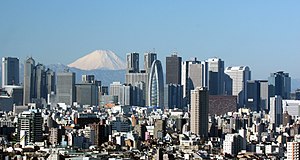Economy of Japan

Financial center in Tokyo
|
|
| Currency | Japanese yen (JPY) = 0.01USD |
|---|---|
| 1 April – 31 March | |
|
Trade organisations
|
APEC, WTO, OECD, G-20, G8 and others |
| Statistics | |
| GDP | $4.41 trillion (nominal; 2016) |
| GDP rank | 3rd (nominal) / 4th (PPP) |
|
GDP growth
|
|
|
GDP per capita
|
$34,870 (nominal; 2016) (nominal; 24th / PPP; 23rd) |
|
GDP by sector
|
agriculture: 1.2%, industry: 27.5%, services: 71.4% (2012 est.) |
| deflation | |
|
Population below poverty line
|
16% (2010) |
| 38.1 (2002) | |
|
Labour force
|
66 million (2011 est.) |
|
Labour force by occupation
|
agriculture: 3.9%, industry: 26.2%, services: 69.8% (2010 est.) |
| Unemployment | 3.4% (2015 est.) |
|
Main industries
|
Motor vehicles Electronic equipment Machine tools Steel and nonferrous metals Ships Chemicals Textiles Processed foods |
| 34th (2017) | |
| External | |
| Exports | $697 billion (2013 est.) |
|
Export goods
|
motor vehicles 13.6%; semiconductors 6.2%; iron and steel products 5.5%; auto parts 4.6%; plastic materials 3.5%; power generating machinery 3.5% |
|
Main export partners
|
|
| Imports | $767 billion (2013 est.) |
|
Import goods
|
petroleum 15.5%; liquid natural gas 5.7%; clothing 3.9%; semiconductors 3.5%; coal 3.5%; audio and visual apparatus 2.7% |
|
Main import partners
|
|
|
FDI stock
|
$1.41 trillion (2013) |
|
Gross external debt
|
$2.767 trillion (Q3 2014 est.) |
| Public finances | |
| 245.80% of GDP (2015 est.) | |
| Revenues | $1.74 trillion (2013 est.) |
| Expenses | $2.15 trillion (2013 est.) |
| Economic aid | $9.7 billion ODA (February 2007) |
|
Standard & Poor's: AA- (Domestic) AA- (Foreign) AAA (T&C Assessment) Outlook: Stable Moody's: A1 Outlook: Positive Fitch: A- Outlook: Positive |
|
|
Foreign reserves
|
US$1.264 trillion (Sep 2014) |
The economy of Japan is the third-largest in the world by nominal GDP and the fourth-largest by purchasing power parity (PPP). and is the world's second largest developed economy. According to the International Monetary Fund, the country's per capita GDP (PPP) was at $37,519, the 28th highest in 2014, down from the 22nd position in 2012. Japan is a member of the G7. The Japanese economy is forecasted by the Quarterly Tankan survey of business sentiment conducted by the Bank of Japan.Nikkei 225 presents the monthly report of top equities on Japan Exchange Group. Due to a volatile currency exchange rate, Japan's GDP as measured in dollars fluctuates widely. Accounting for these fluctuations through use of the Atlas method, Japan is estimated to have a GDP per capita of around $38,490.
Japan is the world's third largest automobile manufacturing country, has the largest electronics goods industry, and is often ranked among the world's most innovative countries leading several measures of global patent filings. Facing increasing competition from China and South Korea,manufacturing in Japan today now focuses primarily on high-tech and precision goods, such as optical instruments, hybrid vehicles, and robotics. Besides the Kantō region, the Kansai region is one of the leading industrial clusters and manufacturing centers for the Japanese economy. Japan is the world's largest creditor nation Japan generally runs an annual trade surplus and has a considerable net international investment surplus. As of 2010, Japan possesses 13.7% of the world's private financial assets (the third largest in the world) at an estimated $13.5 trillion. As of 2015, 54 of the Fortune Global 500 companies are based in Japan, down from 62 in 2013.
...
Wikipedia
